On November 10th, the Ecole hotelière de Lausanne had the pleasure to hold a virtual conference hosted by Mr. Pascal Ravessoud, External Affairs Director & Watchmaking Expert at Fondation de la Haute Horlogerie. We learnt a lot about the history of fine Swiss watches and the industry as a whole. Mr. Ravessoud was also able to highlight the several challenges and opportunities which emerged following the COVID crisis. Here, we summarize the main points of the webinar for a better understanding of the coming trends in the world of fine watchmaking.
A brief history of time telling and watchmaking
First, let’s rewind a bit. We believe it was around 1450 BC that civilizations of the world first tried to measure time, after observing consistent patterns of daylight and darkness. They initially used calendars before developing more precise instruments. We could talk about everything that’s happened in the watchmaking industry ever since, but that’s not the goal. However, if you’re interested, feel free to visit the official website of FHH, which offers a very visual and self-explanatory guide.
From 1900 to 1930, pocket watches became less and less popular, due to the many wars that highlighted the non-practical side of wearing them on the battlefield. This led to the appearance of wrist watches which rapidly grew in popularity. In 1970, the Quartz technology shook the industry with cheaper and more precise pieces. The Swiss market almost collapsed and 2/3 of jobs were lost. However, the rebirth of mechanical watches occurred in 1990. Slowly, they started to be seen as an object symbolizing know-how, culture and heritage. Usefulness wasn’t the main concern anymore. With the 21st century, the so-called Haute Horlogerie finally had its breakthrough. Indeed, in the last 20 years, there has been an unprecedented growth of Swiss watches exports in value (10'297 mio CHF in 2000 vs 21'680 mio CHF in 2019). In the middle of this ascension, two big groups earned themselves a comfortable spot: Swatch and Richemont.

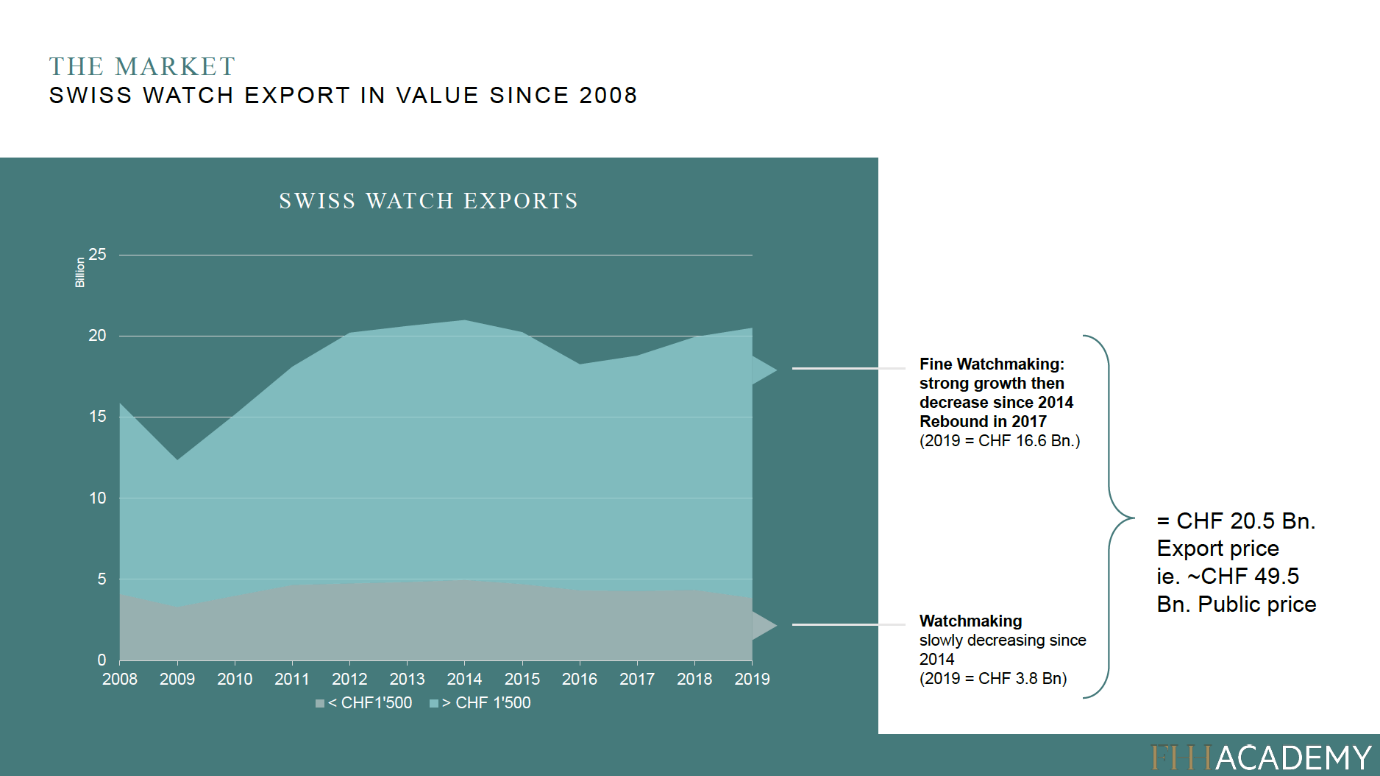
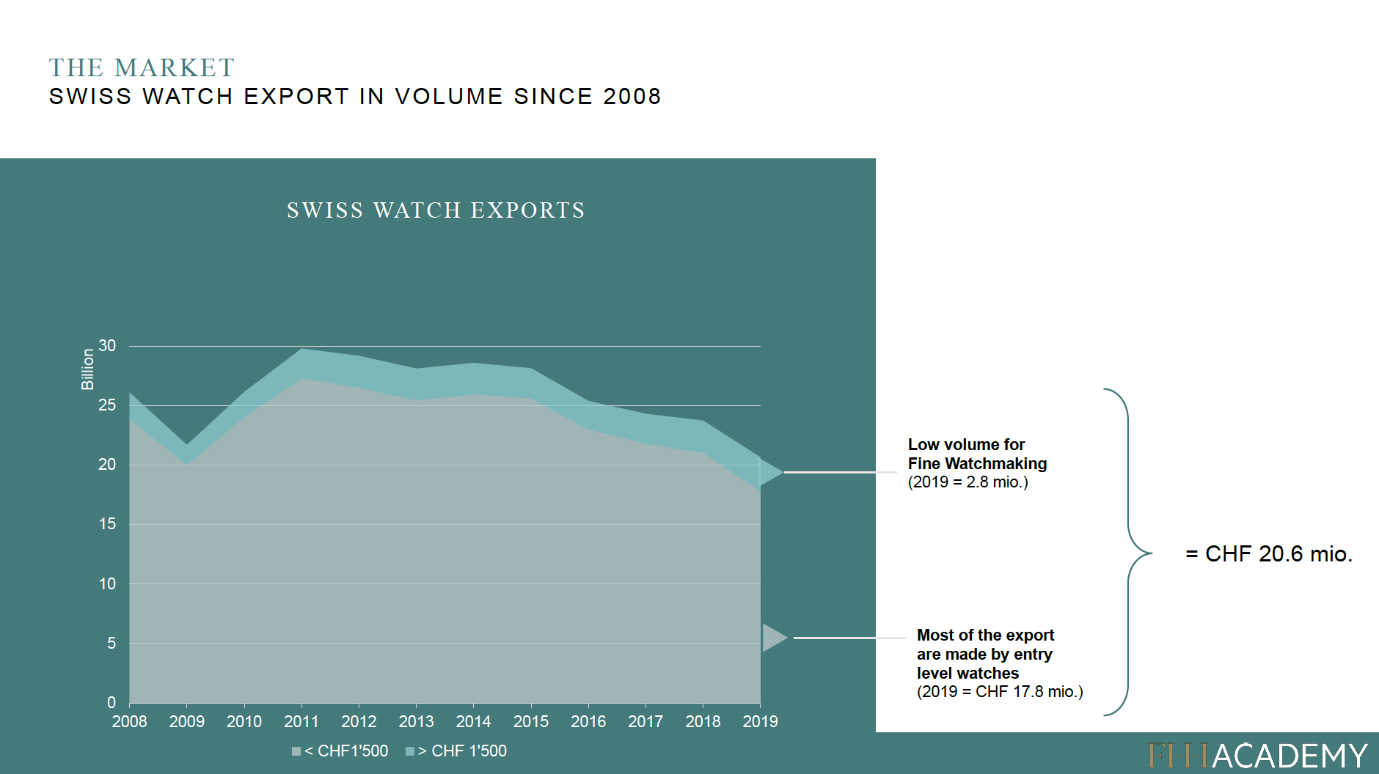
High-end watches have accounted for the biggest growth in the industry over the last decade (fine watches = more than 1500 CHF in value; higher-end = more than 3000 CHF in value). However, since 2018, we’ve seen a slow-down in the growth of the fine watchmaking industry (+2.3% only). This could be explained by a downtrend in volume for all types of watches that has been observed since 2014.
Now, here’s a striking number: Swiss fine watchmaking accounts for only 14% of total Swiss watches sales in volume but more than 81% in value in 2019. Fine watchmaking accounts for only 2.8 million out of the 20.6 million watches sold in 2019, while generating 16.6 billion in value. It says a lot about the concentration of fine watchmaking brands and their importance in the market.
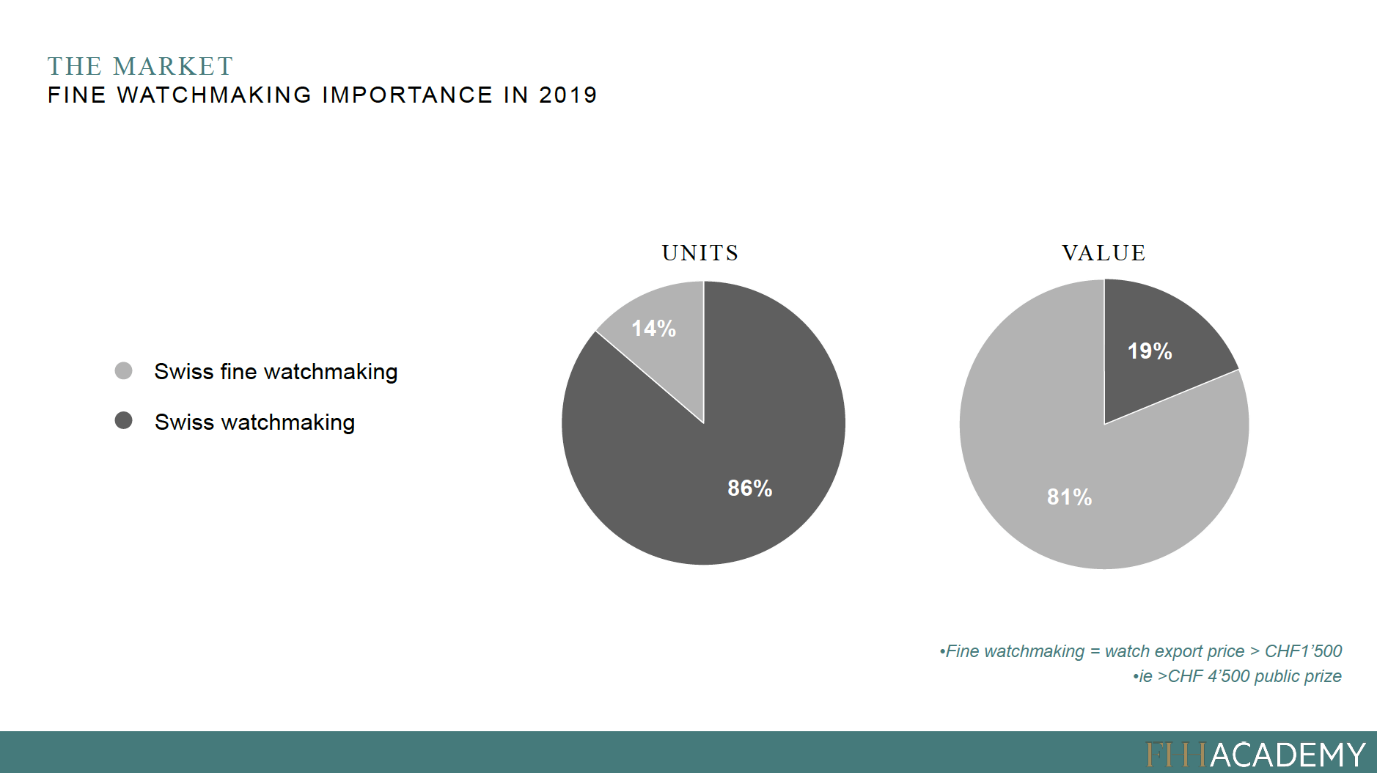
In 2019, the luxury market as a whole was estimated at 1365 billion CHF, of which 25% were personal luxury goods (300 billion CHF). Luxury watch sales reached 50 billion CHF, meaning that segment accounted for only 3.5% of luxury market.
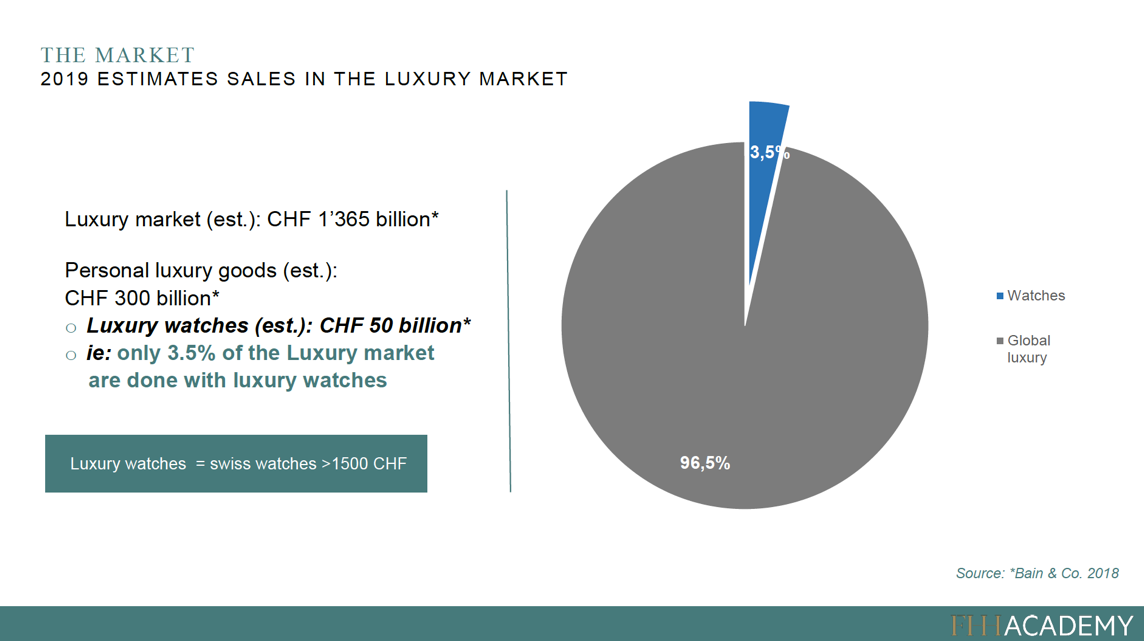
About 1.2 billion watches were produced worldwide in 2019:
- Asia: 94%/ Europe + USA: 4%/ CH: 2%
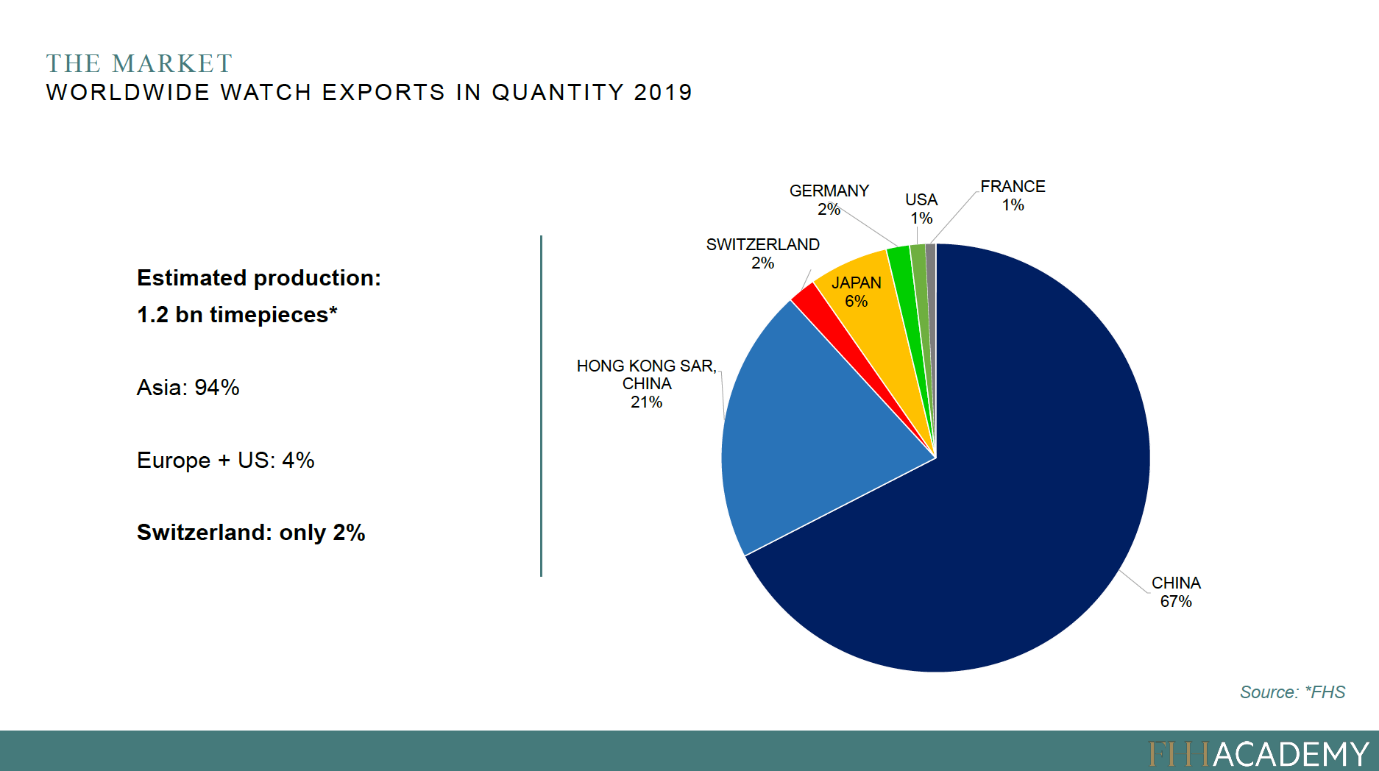
In terms of value, out of the 50 billion CHF in sales in 2019:
- Asia: 33%/ Europe + US: 16%/ CH:51% (21.8 bn)
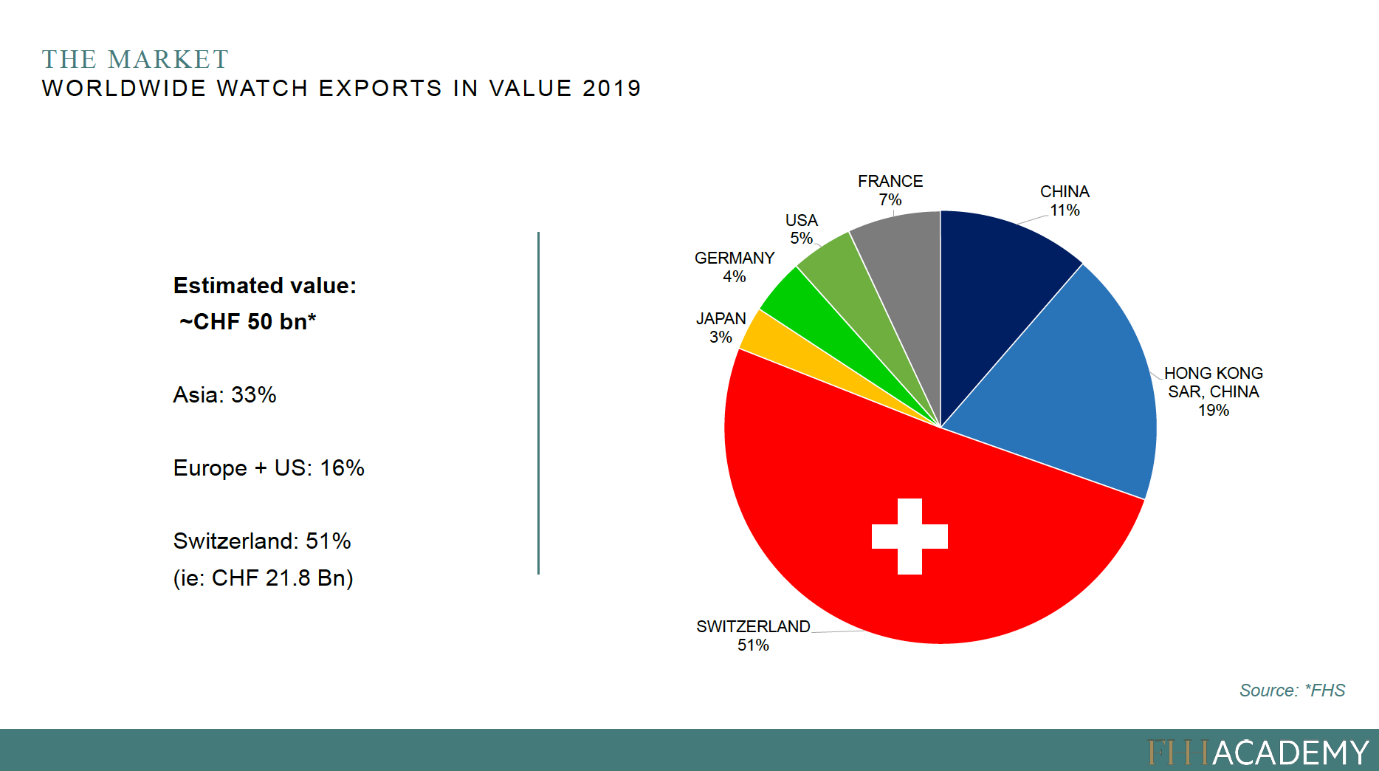
As you can easily guess, Switzerland has a huge presence in the fine watchmaking marketplace with more than half of exports in value. There are about 60'000 employees across 700 companies, mainly located in Geneva, Jura area, Vallée de Joux, Neuchâtel/ La Chaux-de-Fonds, Bienne and Schaffhausen.
Mr. Ravessoud also points out that Asia remains the most important market for Swiss brands (42%), with Chinese sales growing significantly in the last few years (+4223% between 1999 and 2019). Europe takes second place (30%) and USA & Canada complete the podium (12%).
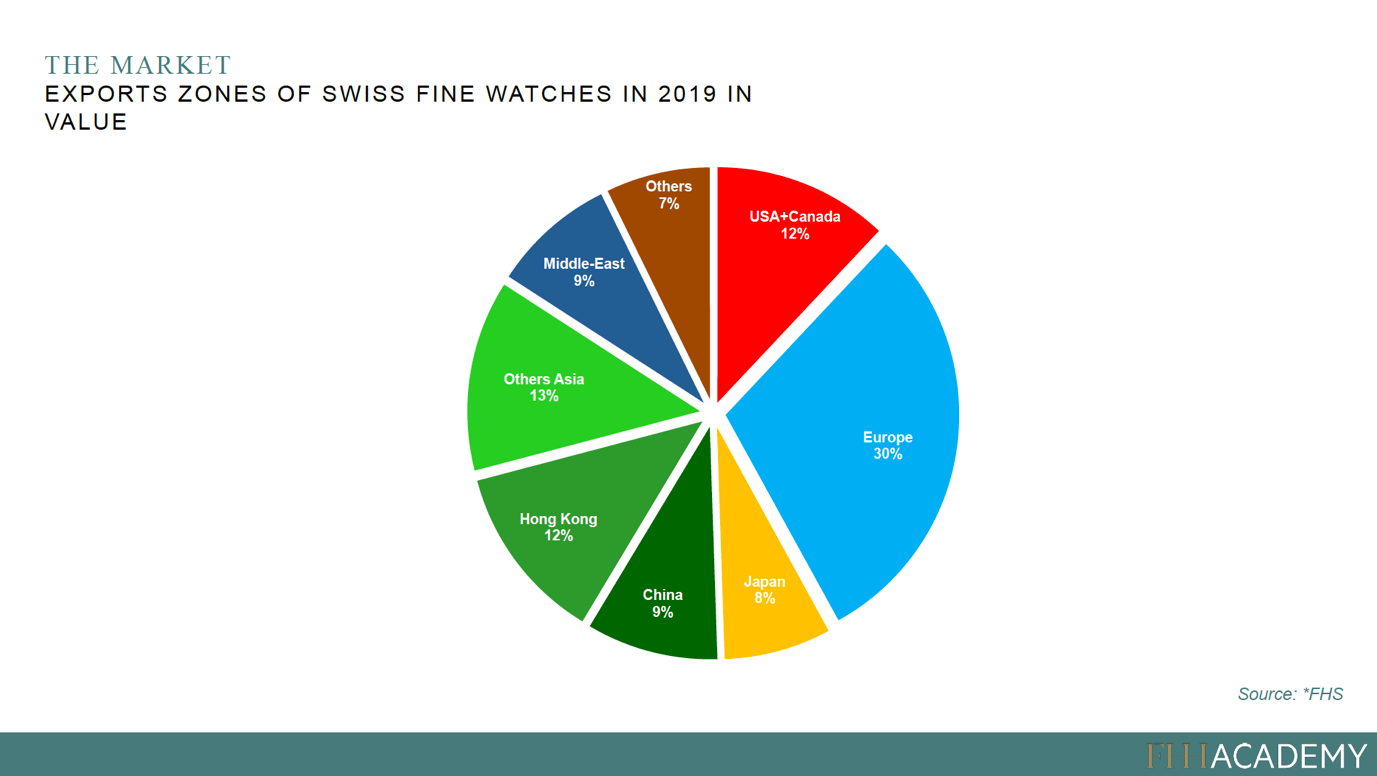
A quick word about the main players in this industry. Groups account for more than 65% of sales, independent brands 30% and artisans-creators 5%.
The current situation for the Watchmaking Industry in 2020
As you can imagine, it’s been complicated since mid-March 2020, when COVID-19 impacted most of the world. Indeed, a decrease of 80% in Swiss sales was observed. Switzerland closed down, all the markets followed. 91% of worldwide selling points shut down for several weeks and months. At the end of September 2020, Swiss sales were 28% down compared to last year, which is frustrating but not that bad taking COVID into consideration.
Now, let’s talk about China. As mentioned, this market has been growing exponentially in the last few years. They got hit very early by the virus but also recovered more quickly and “easily”. The government put in place a strict and generalized lockdown, allowing shops to re-open sooner than expected. “After the nine first months of 2020, China was up by 10% compared to last year. In September alone, they were up by 78% compared to last year!!” explains Mr. Ravessoud. Those are mind-blowing figures when you think about the impact of the virus all around the world. It shows that the industry relies a lot on China right now. These numbers can be partly explained by the drastic increase of domestic demand following the travel restrictions, which we still face today. However, non-traveling Chinese will obviously not compensate the loss. We still expect 2020 to be the worst year since FH statistics exist, as we’re likely to exceed losses observed in 2009 (-22% in value).
Future challenges and what tomorrow could look like
Nobody can accurately predict what will happen in the future, but Mr. Ravessoud believes it will take at least 2–3 years before we can come back to normal figures. “People need to be able to travel again. It’s essential they can get back into a shop, feel the product and understand the story behind it. Of course, the economy also has to get back on track before the demand can grow again”. Right now, there’s also this huge question of cash flows. Numerous companies are short on cash and a lot of uncertainty remains. Many governments have been able to provide some financial help but it’s unclear until when this will continue. “In Switzerland, we’ve been very lucky as the measures put in place have been effectively helping companies to survive during the crisis. But it won’t last forever.”
“One thing we know is that there will be more concentration” Mr. Ravessoud says. “Some brands will either disappear, merge or be bought with/by other ones. We will see less players in the fine watchmaking industry after this crisis”. Suppliers have also been hit very hard. They’re usually small companies with less cash flows and smaller operations. They rely on orders from big brands which aren’t coming in anymore. Many jobs have already been lost.
As previously explained, since 2014, there’s been a clear downtrend in volume. Less and less watches are being sold, but the overall value isn’t diminishing. That means we sell more fine watches. In addition, smart watches came as a huge competitor at the entry level (under 1000 CHF, certainly under 500 CHF) with a very appealing value proposition. Many people who were ready to buy mechanical watches decided to go for smart watches instead. This contributed to lower sales of fine watches, negatively affecting the suppliers, who actually need volume to make a living.

The role of digitalization
Over the past few months, we’ve seen an acceleration of digitalization. It’s safe to say not all watchmakers have found it easy to keep up with the pace of change. As a matter of fact, fine watchmaking is a relatively slow industry, focusing more on the long-term. In a COVID context, it is key to find new ways to get to the clients. Therefore, it is no surprise that brands who were able to react quicker to digitalization have been less affected by the crisis.
Sales through digital platforms helped several companies to mitigate the losses generated in the physical shops. Mr. Ravessoud insists a key for the future will be to “have a mix between digital and physical touch points in terms of sales and distribution (Phygital)”. He goes on, “distribution models have to evolve massively and quickly, as digital will become the norm”. Furthermore, an integration of e-commerce into the mix will make it more transparent for customers.
Mr. Ravessoud believes watchmakers need to increase their reactivity. “Before COVID, brands would usually unveil their new products in salons like Basel World or SIHH around March. Sometimes, you had to wait until November or even the year after to find the same watches in a shop and be able to purchase one”. Now, many companies are willing to make their products available for sale as soon as the marketing campaign has been launched. “Even if fine watches are very complicated to produce, it is inevitable that the demand will have to be satisfied much quicker.” As an example, in the last few months, we’ve seen more interactions between brand boutiques and the retailers (multi brand operators) in order to accelerate the distribution process.
On one side, low-end watchmakers have considerably suffered from the crisis as many people lost their purchasing power along with their jobs and the willingness to buy watches. On the other side, high-end watchmakers saw a considerable proportion of demand, only deferred to when buyers could come and purchase the products (revenge shopping). “Despite the crisis, the interest for fine watches is still there” insists Mr. Ravessoud. “In China, for instance, markets have already re-opened and sales are increasing rapidly. We organized an event in Shanghai in September and people were very eager to purchase watches.”
As soon as sanitary measures will ease down in other countries, the global market is likely to recover too. “Digital is fine, it can help, but I think that physical contact with the watches is important. Experiencing a product with your own eyes is pretty different than having a quick look at it through a zoom call.” Recently, many brands have also come up with fresh initiatives and were able to convert customers. It is clear that people are still open to buying convincing and fairly-priced products.
In terms of events, most of them have inevitably been cancelled. Thanks to FHH, digital platforms have been rapidly (less than 6 weeks) put in place for many companies as an alternative to launch new products and continue to sell watches. It was actually well-received by customers. For now, most events planned for 2021 are maintained but it is unclear whether they will happen virtually or in-person. Obviously, everyone still hopes that physical interactions with customers can resume as soon as possible, as digital solutions probably aren’t enough for this kind of product. One big question remains: when will we be able to travel again ?
To sum up, as Mr. Ravessoud states: “The interest for mechanical watches is still there and vibrant, despite Switzerland having lost the smart watches war. We need emotional products to increase the value proposition and boost the engagement of people.” The health crisis has certainly brought up many challenges but also have given us opportunities to seize. The evolution of digitalization and distribution models are probably the most important ones. To continue to thrive, watchmakers will have to increase their reactivity and adapt the speed at which they operate. The fine watchmaking industry has always recovered from major crisis and there’s no reason it won’t be the case with this one…
Q&A with Mr. Ravessoud
Question 1: Would you say that, today, legacy watchmakers are threatened by more bold and avant-garde positioning from younger brands ?
No. Legacy is making pretty much an impression. Good things for watchmaking are diversity, innovation, different value proposition, culture. There’s space for a lot of players. A threat would be the younger generation going away from the traditional watchmaking industry because they believe it has become useless and boring. I don’t see that happening in the near future.
Question 2: Have you been able to notice a shift from the boutique sales to online sales in the last 10 years ?
Yes, definitely. A shift is a maybe a big word though. In 2019, online sales for a major brand accounted for about 10% of total sales. Ten years ago, it was almost nothing with less than 1% of total sales. Today, the younger generation is much more ready for digital transactions, even for expensive products. However, I doubt that this will be the majority in the coming years. Less boutique sales than online sales, I don’t see that happening within the next 10–15 years…
Question 3: Which digital trends do you think are the future of luxury watch retail ?
Wow (laughs), that’s a difficult one. I’m not a specialist in digitalization as such, but I think that what we need is for online customers to get a sense of the product. Anything that will bring the customer closer to the product is great. This can happen through animation and virtual reality. 3D modelizations, for example, can do amazing things. We’ve already done a few experiments in 3D, fully immersive ones with the lenses, and it’s really promising. For me, it would never replace physical interaction but I see it as a potentially emerging trend in the industry, either online or in the boutiques.
Question 4: We speak a lot about exportation for the watch industry. But what are the effective revenues coming from sales of high-end watches in Switzerland? (based on when tourists were here)
Swiss people are very shy and don’t buy a lot of watches. Demand mainly comes from tourists. There is no real figure that exists but a few organizations tried to figure it out and if I’m not mistaken, it’s something like 8% of the global turnover which would go in Swiss sales, not to Swiss people but in Swiss boutiques.
Question 5 : Brian Duffy, CEO of Watches of Switzerland Group, once said: “People wear time-telling devices on their wrists because they want something that is an expression of who they are”. Do you think that fine watchmaking is and will overcome the competition from the technologies of the new millennium? Especially after the affirmation of Tim Cook in 2015 who said Apple was a watchmaker.
Two things. First, Tim Cook is not a watchmaker but a device maker bringing a lot of features on a digitally and emotionally void product. Sometimes, they have to compete with watches that happen to tell time as well. Second, I see traditional watches as a product that brings something else, an expression of who your are, a culture, an art. It can be a lot of things, but certainly not just a watch that tells time. Nobody cares about a watch that tells time. You have time everywhere, and it’s often much more precise than mechanical watches. But wearing a real watch is about bringing you emotions, something that makes you smile every time you look at it, something that has meaning for you.







